Many herbaceous plants have the fantastic ability to repel troublesome bugs, fungi, and other vectors of pathogens. They usually contain a complex set of phytochemicals that make them fatally toxic to these pests when ingested or upon physical contact. These compounds may also collectively emit an uninviting and practically offensive scent to them, effectively forcing them to stay as far away from the plant as possible.
Beneficial greens often come in the form of what we perceive as attractive and pleasantly aromatic houseplants. Their natural undesirability to pests is just one of their many appealing features. As they ward off filthy insects like flies and fungus gnats, they add color, texture, structure, and fragrance to the home. Moreover, many of them have a wealth of uses in the kitchen!
During warm or damp periods of the year, when flies are most likely to successfully breed and hatch, it may be necessary to decorate entry points of the home with fly-repellent plants. Though they are not fool-proof solutions to serious infestations, which usually occur when trash is left to fester, they should at least dissuade some curious flies from freely entering your household. For increased effectiveness, grow these species in large quantities.
1) Lemongrass (Cymbopogon citratus)
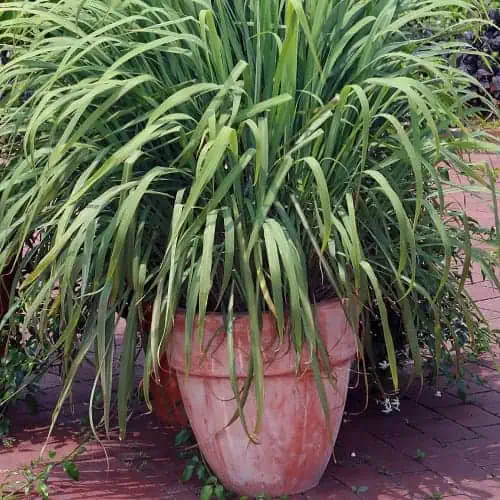
Native to Southeast Asia
A true member of the grass family (Poaceae), lemongrass is a tropical plant with medicinal, culinary, and ornamental uses. It is named for the lemon-like scent emitted by its lengthy leaf blades, which are bluish-green and have parallel veins. The leaves of fully-grown specimens gracefully arch over and emit a fragrance that is strong enough to repel both flies and mosquitoes.
In temperate zones, this tropical plant is best raised in indoor or protected locations as it is not hardy to cool temperatures and frost. Small specimens can be maintained on windowsills receiving at least 6 – 8 hours of direct sunlight per day. Healthy plants produce a cocktail of beneficial compounds with pharmacological properties. Their essential oils can be used as a natural antioxidant and insect repellent.
The fly-repellent properties of C. citratus oils have been formally documented. When applied to materials with substances that are known for attracting flies (e.g. blood), lemongrass oil can serve as a repellent barrier against stable flies (Stomoxys calcitrans) and houseflies (Muscidae). The essential oil contains geraniol and citronellol, which are both known for their repellent properties.
2) Lavender (Lavandula spp.)
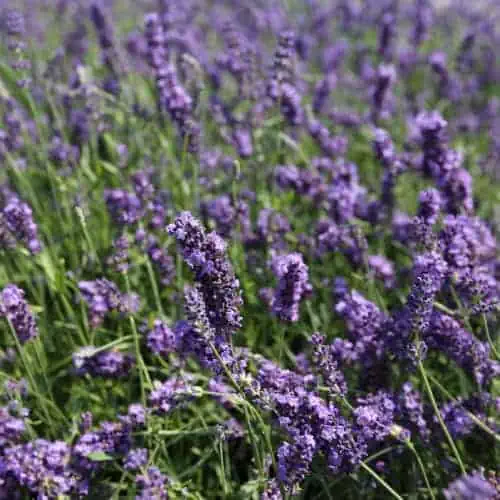
Native to Europe, East Africa, and Southwest Asia
Lavender oils are known for inducing a state of tranquility in us humans, lulling both adults and children to a restful slumber. The oils are unique culinary ingredients with notably strong flavors. Cultivated in many parts of the world, lavender plants have enormous benefits due to the phytochemicals in these lipids. Apart from having uses in herbalism, they also have natural insecticidal properties.
Great for adding color to sprawling gardens and fields, many Lavandula species can be grown in the home. To use them as a repellent, place healthy specimens close to key entry points and around the kitchen, where the smell of food may attract flies. To release more of their heady fragrance, it may be necessary to regularly snip some leaves or wound the plant. For this reason, some people opt to go the more practical route by using the extracted oils and a diffuser.
If your indoor spaces receive minimal sun exposure, it may be wiser to use lavender-scented products instead of growing lavender as a houseplant. Candles, soaps, and dried leaves in pouches are great for emitting a fragrance that wafts through poorly lit rooms. You may also grow lavender as a border plant outdoors, taking care to place its stands close to windows that are regularly opened.
3) Venus flytrap (Dionaea muscipula)

Native to the eastern US
The venus flytrap doesn’t exactly repel flies in a conventional way; instead, it has a more indirect manner of keeping pesky flies away from key points of the home. It has evolved to attract, instead of deter, these very insects. Perhaps the most popular of all carnivorous plants, it can aid in eliminating indoor fly populations by feeding on them.
Flies often find themselves in the “jaws” of the specialized, hinged leaves, unable to wriggle away and escape to safety. These leaves contain sensitive trichomes that, when touched, cause both lobes to forcefully snap shut. The flies are then digested via the activation of enzymes that can break down their exoskeletons. Depending on the size of the fly and the maturity of the plant, the whole process takes about 3 – 5 days.
Apart from being a functional plant in the home, the venus flytrap makes for a great ornamental because of its unusual features. Endlessly fascinating to watch despite its miniature size, it can serve as an educational plant for both adults and young children. To expose it to as many flies as possible, place it in well-lit entranceways and on windowsills.
4) Basil (Ocimum basilicum)
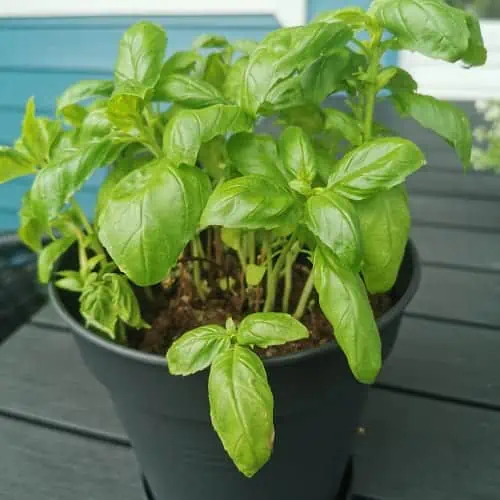
Native to tropical Asia and Africa
One of the most popularly used culinary herbs due to its citrus-like taste, basil is an incredibly useful annual to have in both indoor locations and outdoor gardens. Mechanical damage to its nutritious leaves releases a strong fragrance. Though the smell may appeal to humans, it is practically repulsive to flies, mosquitoes, fleas, and many more troublesome insects.
This herb’s fragrance and delectable flavor are produced by its essential oil. Packed with aromatic compounds, the oil has insecticidal, fungicidal, and nematocidal properties. To flies, the smell of basil is pungent and unbearable. It also signifies the presence of toxic compounds that could potentially harm them. For this reason, basil is frequently planted as a natural repellent around vegetable beds.
To maximize the functional uses of basil in indoor locations, make sure to grow this herb in a brightly lit area with filtered sun exposure and ample ventilation. As fully intact plants may not be highly effective at warding off flies in their vicinity, you should occasionally prune the leaves to expose the internal oils. Don’t make the flavorful leaves go to waste, of course. Chop them up or add them to your dishes whole for flavor and color!
5) Peppermint (Mentha x piperita)

Native to the Middle East and Europe
The most popularly cultivated type of mint is Mentha x piperita, a hybrid between two vigorous species. Commonly known as peppermint, this plant naturally occurs in the wild wherever dense stands of both parent species are found. An herbaceous perennial, it can grow to about 35 inches (89 cm) tall. As this hybrid is unable to produce seeds on its own, its vegetative spread is facilitated by rapidly-growing runners.
Peppermint can be cultivated in indoor containers because it thrives best in locations with partial to dappled sun exposure. Regularly moistened soil and the availability of ample nutrients leads to favorable growth rates. Once the plant begins to produce blooms, its leaves are usually ready for harvesting. When these are plucked off the main shoot, they release a distinctly minty aroma.
The fragrance of peppermint oils, like that of basil, is detestable to small flies and many other winged insects. It mainly contains pulegone and menthone, compounds with natural pesticidal properties. These ketone monoterpenes are toxic to insects and can disrupt the normal functions of their neuronal pathways.
6) Catnip (Nepeta cataria)

Native to Europe and Asia
A fragrant herb that elicits bizarre behavior in some cats, N. cataria is valued by herbalists for the relaxant properties of its essential oil. It is thus often added to tea infusions that are intended for use as natural sedatives. Apart from being a source of valuable oils, it is widely cultivated as an ornamental plant. Though this herb’s fragrance tends to repel houseflies and stable flies, its blooms attract pollinators and beneficial insects (e.g. butterflies and lacewings).
The main component of catnip oil is a terpenoid called nepetalactone. As a natural fly repellent, nepetalactone has been shown to be remarkably effective. Its deterrent effects rival or surmount those of DEET, which is a common ingredient in artificially-formulated repellents. Catnip oil has shown potential as a substitute for industrial insecticides in pastures and feedlots where insects often attack livestock.
To grow catnip indoors, make sure its pot is situated in an area that receives bright light for at least 6 hours a day. Light is crucial for its normal growth and the production of its essential oil. Catnip should be rooted in a well-draining substrate and in a porous pot with drainage holes. Regular fertilization and pruning should keep its shoots and roots in good condition.
7) Sage (Salvia officinalis)

Native to the Mediterranean
An ornamental plant, source of fragrant essential oils, and a fantastic culinary ingredient and garnish for European dishes, sage is undoubtedly a valuable herb. Distinguished by its grayish-green, fuzzy leaves, it grows to about 2 feet (61 cm) tall. In late spring to summer, it produces lavender to pink inflorescences. Flower and leaf color may vary as this species comes in dozens of highly-prized cultivars.
The strong aroma of sage, which is released when its leaves and shoot are cut or charred, is traditionally believed to ward off evil. The jury’s out on whether it can truly repel troublesome spirits, but it can, indeed, keep unwanted insects away from the hearth and the home! Freshly cut sprigs of the plant should be placed in various locations to expand the reach of its scent.
Apart from repelling flies, ticks, and mosquitoes, the fragrance of sage can supposedly act as a mood booster! That alone is a compelling argument for growing this attractive herb indoors. Relatively drought-tolerant, sage makes for a low-maintenance houseplant. To keep its leaves in good condition, simply make sure that they are exposed to medium to full sun.
8) Lemon balm (Melissa officinalis)
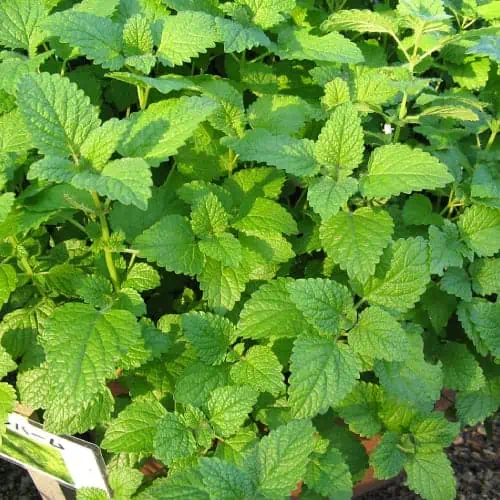
Native to the Mediterranean and Central Asia
Another strongly-scented member of the mint family (Lamiaceae), lemon balm is an herbaceous perennial with many natural and herbal uses. It is deliberately cultivated as a source of ingredients for medicinal teas and as a flowering plant to attract honey bees. Its small, white blooms, which appear in summer, are rich in nectar whereas its leaves are rich in its lemon-scented essential oil.
Lemon balm oil contains many insecticidal and acaricidal compounds. Those which specifically repel flies include citronellal, linalool, neral, and geraniol. The predominance of these components is largely determined by the strain of M. officinalis and the conditions in which it is grown. Thus, the extracted oils of the plant are often mixed with those of citronella and lemon to increase their potency.
Lemon balm is fairly straightforward to grow indoors. All it requires is a pot of pathogen-free, well-draining soil. To prevent the soil from collecting too much water, make sure the pot has drainage holes. Leaf production should be accelerated by exposure to at least 5 – 6 hours of sun per day. Compared to other fragrant herbs, this plant is more likely to thrive in partly shaded conditions.
9) Marigold (Tagetes spp.)

Native to the southwestern US, Central America, and South America
The leaves of most marigold species are known for their somewhat pungent and heavy scent. This fragrance, when emitted by large stands, can keep dozens of insects and nematodes away from the garden.
Among the more common marigolds, the French marigold (T. patula) and African marigold (T. erecta) have shown the most potential when it comes to their insect-repellent properties. This is largely due to their thiophenes, which are sulfur-containing compounds. Thiophenes repel not only flies but also aphids, maggots, and many other destructive insects.
Interestingly, though marigolds tend to repel unwanted pests, their blooms can attract beneficial insects, including beneficial flies (e.g. hover flies). Of course, they are less likely to attract insects at all if they are kept indoors. To ensure that they are healthy enough to produce stunning blooms and new foliage, keep their substrate regularly moistened yet well-ventilated. Keep marigolds close to a south-facing window that receives about 6 hours of direct sun per day.
10) Rosemary (Salvia rosmarinus)
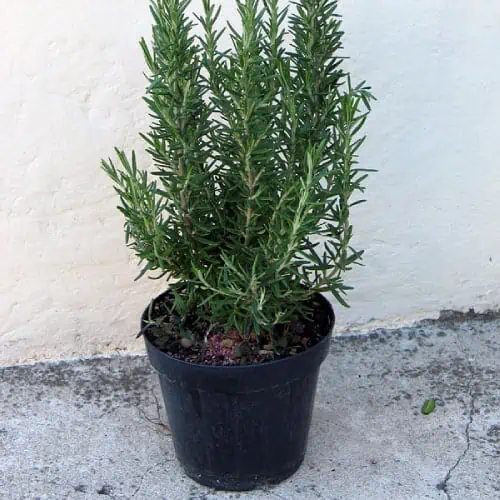
Native to the Mediterranean
Troublesome flies and many other pests generally keep away from areas with dense stands of rosemary. Though this evergreen species is often known as an herb, it can exhibit upright, shrub-like growth as its older stems become increasingly woody. The stiff, needle-like leaves are rarely browsed by herbivorous animals, which may be sensitive to their bitter flavor and strong scent.
Several rosemary cultivars have received the RHS Award of Garden Merit due to their ease of care, attractive features, and general usefulness in the garden. When situated indoors, these plants can be grown as hardy miniatures. To maximize their effectiveness against flies, you may opt to collect some of the leaves and shoots and spread them around the home. The exposed tissues, which emit more of the essential oil, should produce a more concentrated scent.
To retain the healthy condition of rosemary cuttings once they are propagated indoors, make sure to gradually acclimate them to the reduced light intensity. With tough shoots that can persist through winter, rosemary should be watered only when the topsoil has dried out. With consistent ventilation, the leaves are more likely to flourish and produce enough oils to deter hungry flies.
- Medicinal Garden
- With your seeds kit, you’ll also receive a FREE Medicinal Guide that shows you how to turn these 10 plants into tinctures, ointments, salves, poultices, decoctions, infusions, essential oils —all in minute detail so you can follow our guide even if you’ve never made an herbal medicine in your life.
Books can be your best pre-collapse investment.
Carnivore’s Bible (is a wellknown meat processor providing custom meat processing services locally andacross the state of Montana and more. Whether your needs are for domestic meator wild game meat processing)
The Lost Book of Remedies PDF ( contains a series of medicinal andherbal recipes to make home made remedies from medicinal plants and herbs.Chromic diseases and maladies can be overcome by taking the remediesoutlined in this book. The writer claims that his grandfather was taughtherbalism and healing whilst in active service during world war twoand that he has treated many soldiers with his home made cures. )
Easy Cellar(Info about building and managing your root cellar, plus printable plans. The book on building and using root cellars – The Complete Root Cellar Book.)
The Lost Ways (Learn the long forgotten secrets that helped our forefathers survive famines,wars,economic crisis and anything else life threw at them)
LOST WAYS 2 ( Wordof the day: Prepare! And do it the old fashion way, like our fore-fathers did it and succeed longbefore us,because what lies ahead of us will require all the help we can get. Watch this video and learn the 3 skills that ensured our ancestors survival in hard times offamine and war.)




